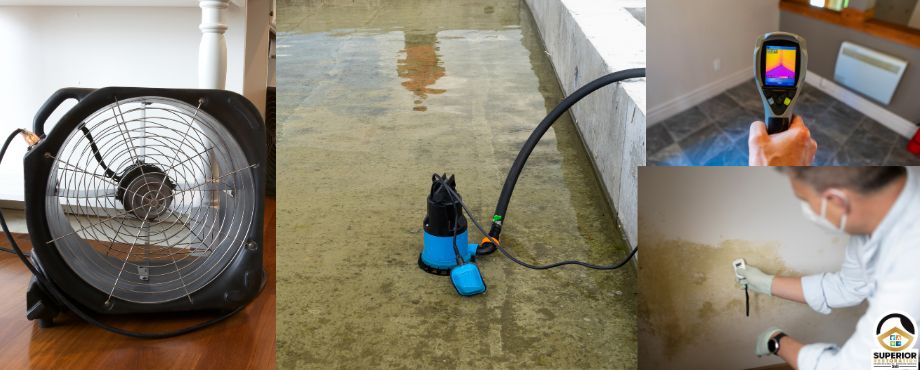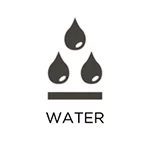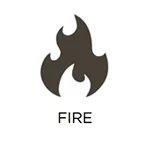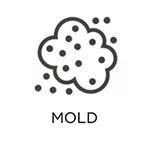Superior Restoration Services
If there’s heavy rain, flooding, a toilet overflow, sewer backup, or burst pipe, you might end up with water inside your place. These situations can happen for different reasons, like bad weather or problems with plumbing. When water gathers inside, it can cause big problems. It can damage floors, walls, and your things, and it might even make you sick if it’s dirty.
Superior Restoration Services stands as a trusted restoration company in Randolph, New Jersey, specializing in handling water damage emergencies. Our team of certified experts excels in water removal and property drying, to ensure effective restoration.
Keep in mind, even just a few inches of water can pose a significant threat to your home or office.
Categories of Standing Water
There are primarily three categories of standing water, such as:
- Clear Standing Water: Clear standing water refers to water that is visibly transparent and free of any visible impurities or contaminants. This type of standing water may accumulate due to rainfall, groundwater seepage, or plumbing leaks. While clear standing water may appear safe, it can still pose health risks if left stagnant for an extended period, as it can become a breeding ground for mosquitoes and other pests.
- Sewage Standing Water: Sewage standing water, also known as black water, is highly contaminated with human waste, pathogens, and other harmful substances. This type of standing water typically originates from overflowing sewer lines, sewage backups, or toilet overflows. Sewage standing water poses significant health risks to humans and animals due to the presence of bacteria, viruses, and parasites.
- Graywater Standing Water: Graywater standing water is wastewater generated from household activities such as bathing, washing dishes, and laundry. While not as heavily contaminated as sewage, graywater still contains varying levels of organic matter, chemicals, and pathogens. Graywater standing water may result from leaks in plumbing fixtures or appliances, inadequate drainage, or improper disposal practices. Although not as hazardous as sewage standing water, prolonged exposure to graywater can pose health risks and contribute to mold growth and unpleasant odors.
What is Water Extraction?
Water extraction involves removing excess water from a property after flooding or leaks using specialized equipment like pumps and vacuums. This is critical for preventing further damage to the building and its contents, as prolonged moisture can lead to mold and structural issues.

What Tools Our Professionals Use To Extract Water?
For water mitigation, we use the following:
- Water Pumps: Our company relies on powerful water pumps to remove large volumes of water from flooded areas effectively. Whether it’s submersible models for submerged areas or portable options for accessible spaces, our range of pumps ensures efficient water extraction in any situation.
- Wet/Dry Vacuums: Our experts use versatile wet/dry vacuums to extract water from various surfaces like floors, carpets, and upholstery. These vacuums are essential tools in our toolkit, capable of handling both wet and dry materials with ease.
- Dehumidifiers: To accelerate the drying process and prevent mold growth, we use high-quality dehumidifiers that effectively reduce humidity levels in the air. By extracting excess moisture from the environment, our dehumidifiers facilitate faster drying of surfaces and contents, ensuring comprehensive restoration outcome.
- Moisture Meters: Our expert technicians use accurate moisture meters to check how much water damage there is and to track drying progress. These tools help us measure moisture levels in different materials, guiding our restoration work and making sure we remove all the moisture thoroughly.
- Air Movers/Fans: We strategically place air movers and fans to promote airflow and expedite moisture evaporation from wet surfaces. By directing air across affected areas, our equipment accelerates the drying process, preventing stagnation and facilitating faster restoration.
- Infrared Cameras: Our experts use state-of-the-art infrared cameras to detect hidden pockets of moisture within building materials. By capturing thermal images, these cameras help us pinpoint areas of elevated moisture levels.
Our Water Mitigation Process
Upon receiving your call, our team, equipped with cutting-edge equipment, promptly arrives at your location. We initiate our process by conducting a comprehensive inspection and assessment to identify the source of the leak and assess potential safety hazards. Our first priority is to stop the water flow to create a safe work environment and prevent further damage. Using pumps and vacuums, we quickly remove standing water, followed by utilizing advanced water extraction techniques to address hidden moisture. Before proceeding, we meticulously address safety hazards, ensuring thorough disinfection and deodorization for a fresh environment. Finally, we use a professional-grade dehumidification to eliminate any remaining moisture, leaving your property revitalized and protected against mold and mildew.
Don’t Delay! Call Now to Remove Standing Water (973) 381-2313
Related Water Damage Restoration Information
Who’s Responsible for Water Damage: Tenants or Landlords?
Determining who’s responsible for water damage in rental properties can vary based on what caused the damage and what’s stated in the lease. Typically, landlords are in charge of keeping the property’s structure sound, including plumbing and structural issues like leaks or burst pipes. So, if the water damage is because of something like a roof leak or faulty plumbing, it’s usually the landlord’s job to handle repairs. However, if the tenant is at fault, like not reporting a leak or damaging the property, then they might have to cover the repair costs. It’s really important for both landlords and tenants to go through their lease agreements carefully to understand who’s responsible for what when it comes to water damage and maintenance.
The Dangers of Stagnant Water & How to Remove it?
Stagnant water isn’t just a nuisance—it’s a serious hazard for both health and property. It can attract pests like mosquitoes and promote the growth of mold and mildew, leading to health issues and damage to your home or building. To get rid of stagnant water effectively, you have a few options depending on how much water you’re dealing with. For small amounts, you can use buckets or wet vacuums, but for larger areas, you might need to bring in professional-grade pumps or equipment. After getting rid of the water, it’s crucial to thoroughly dry and disinfect the area to prevent any further problems.
How to Deal with Water Damage Ceiling Bubble?
When you discover a water-damaged ceiling bubble, swift action is crucial to minimize additional damage and ensure safety. Begin by identifying and resolving the source of the leak, whether it stems from a burst pipe or a problem with the roof. Gently puncture the bubble to release the trapped water, placing a container underneath to catch any dripping. Then, meticulously clean up any remaining moisture using towels or a vacuum. Once the area is dry, assess the extent of the damage and consider seeking professional assistance to restore the ceiling to its original condition.
Frequently Asked Questions About Water Damage Repair and Cleanup
How long does it take to restore a home after water damage?
The time needed to restore a home after water damage depends on its severity. Minor incidents may take only a few hours to clean up and repair, while more extensive damage could require several days or even weeks for complete restoration.
Is water damage restoration covered by my insurance?
Your insurance policy may cover water damage restoration, but it depends on the specifics of your coverage. Generally, standard homeowners insurance covers sudden and accidental incidents such as burst pipes. To confirm coverage, check your policy or ask your insurance provider directly.
Why is water damage so expensive?
Water damage can be costly because it requires extensive repairs to both structures and belongings. It requires specialized equipment and techniques, and if not addressed promptly, it can lead to additional issues like mold growth, which further increases costs.
Recent Reviews
Review by Julie Ann Kulinski
Disaster Restoration

"Matt and his crew are wonderful! Fantastic customer service! They came out and took care of my issue the same day that I called."
Review by Michael Dunham
Disaster Restoration

"Matt and his team responded, communicated and restored my home back after a flood in our home. Couldn’t be any happier with them and their professionalism. They really are Superior!!!"
Review by Justin Rauch
Disaster Restoration

“Matt is a great guy, super knowledgeable and will get you taken care of.”
See All Reviews




